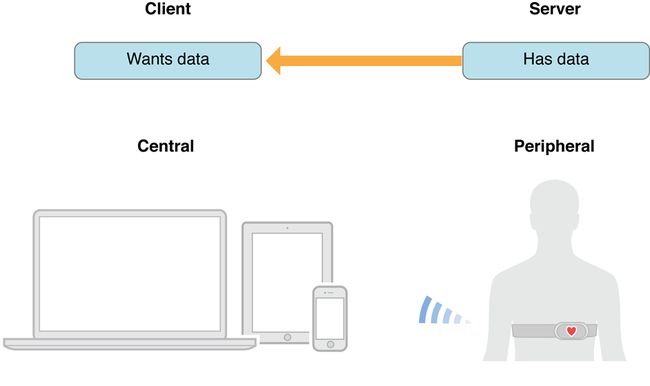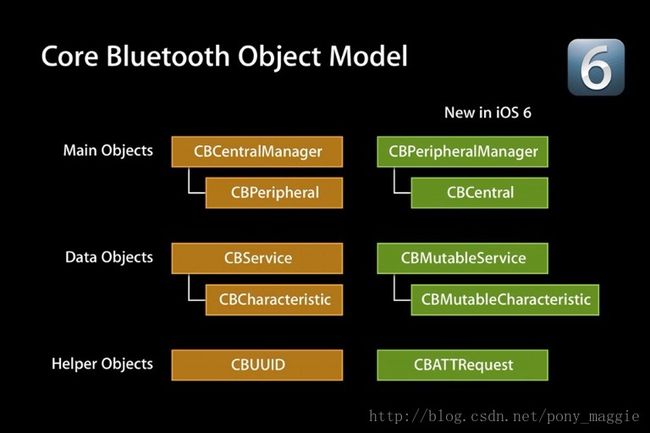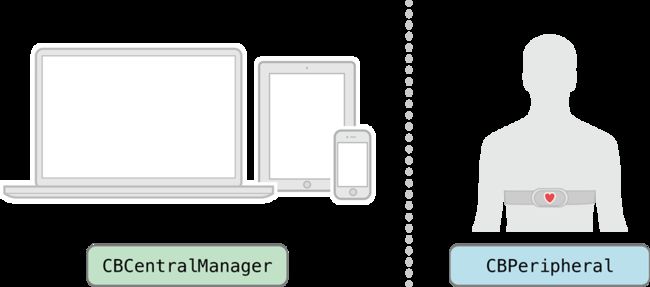本文主要参考如下链接:
http://blog.csdn.net/pony_maggie/article/details/26740237
http://blog.csdn.net/VictorMoKai/article/details/42395669
http://blog.csdn.net/m372897500/article/details/50662976
iOS 蓝牙介绍
蓝牙协议本身经历了从1.0到4.0的升级演变, 最新的4.0以其低功耗著称,所以一般也叫BLE(Bluetoothlow energy)。
iOS 有两个框架支持蓝牙与外设连接。一个是 ExternalAccessory。从iOS3.0就开始支持,也是在iPhone4S出来之前用的比较多的一种模式,但是它有个不好的地方,External Accessory需要拿到苹果公司的MFI认证。
另一个框架则是本文要介绍的CoreBluetooth,在iphone4s开始支持,专门用于与BLE设备通讯(因为它的API都是基于BLE的)。这个不需要MFI,并且现在很多蓝牙设备都支持4.0,所以也是在IOS比较推荐的一种开发方法。
CoreBluetooth介绍
CoreBluetooth框架的核心其实是两个东西,Peripheral和Central, 可以理解成外设和中心。其中Peripheral外设相当于Socket编程中的Server服务端,Central中心相当于Client客户端。
你可以理解外设是一个广播数据的设备,它开始告诉外面的世界说它这儿有一些数据,并且能提供一些服务。另一边中心开始扫描周边有没有合适的设备,如果发现后,会和外设做连接请求,一旦连接确定后,两个设备就可以传输数据了。
在iOS6之后,iOS 设备可以是外设,也可以是中心,就像Socket编程中一样,你可以是服务端也可以是客户端,但与Socket不同的是不能在同时间扮演两个角色。
服务(service)和特征(characteristic)
每个蓝牙4.0的设备都是通过服务和特征来展示自己的,一个设备必然包含一个或多个服务,每个服务下面又包含若干个特征。特征是与外界交互的最小单位。比如说,智能音响设备,用服务A标识播放模块,特征A1来表示播放上一首,特征A2来表示播放下一首;服务B标识设置模块,特征B1设置彩灯颜色。这样做的目的主要为了模块化。
服务和特征都是用UUID来唯一标识的,UUID的概念如果不清楚请自行google,国际蓝牙组织为一些很典型的设备(比如测量心跳和血压的设备)规定了标准的service UUID。
CoreBluetooth框架的核心其实是两个东西,peripheral和central, 可以理解成外设和中心。对应他们分别有一组相关的API和类,如下图所示:
上面说了设备可以是外设,也可以是中心,也就是 本地中心->远程外设 、本地外设->远程中心,
不过在智能家居开发中,大部分硬件蓝牙都是担任外设的角色,也就是说我们应用只要扮演中心即可了。
本地中心与远程外设
在中心这边,由CBCentralManager对象管理本地中心,来发现或连接远程外设。此时
正在连接的外设用CBPeripheral 对象表示。
远程外设的数据由CBService和CBCharacteristic对象表示
当你与远程外设CBPeripheral对象进行数据交互时,是由一个服务与特征操作的。
实现细节
作为一个中心要实现完整的通讯,一般要经过这样几个步骤:
- 建立中心角色
- 扫描外设(discover)
- 连接外设(connect)
- 扫描外设中的服务和特征(discover)
-获取外设的services
-获取外设的Characteristics,获取Characteristics的值,获取Characteristics的Descriptor和Descriptor的值 - 与外设做数据交互(explore and interact)
- 订阅Characteristic的通知
- 断开连接(disconnect)
1.导入CoreBluetooth头文件,建立主设备管理类,设置主设备委托
首先在我自己类的头文件中要包含CoreBluetooth的头文件,并继承两个协议
#import
@interface ViewController (){
//系统蓝牙设备管理对象,可以把他理解为主设备,通过他,可以去扫描和链接外设
CBCentralManager *manager;
}
- (void)viewDidLoad {
[super viewDidLoad];
/*
设置主设备的委托,CBCentralManagerDelegate
必须实现的:
- (void)centralManagerDidUpdateState:(CBCentralManager *)central;//主设备状态改变的委托,在初始化CBCentralManager的适合会打开设备,只有当设备正确打开后才能使用
其他选择实现的委托中比较重要的:
- (void)centralManager:(CBCentralManager *)central didDiscoverPeripheral:(CBPeripheral *)peripheral advertisementData:(NSDictionary *)advertisementData RSSI:(NSNumber *)RSSI; //找到外设的委托
- (void)centralManager:(CBCentralManager *)central didConnectPeripheral:(CBPeripheral *)peripheral;//连接外设成功的委托
- (void)centralManager:(CBCentralManager *)central didFailToConnectPeripheral:(CBPeripheral *)peripheral error:(NSError *)error;//外设连接失败的委托
- (void)centralManager:(CBCentralManager *)central didDisconnectPeripheral:(CBPeripheral *)peripheral error:(NSError *)error;//断开外设的委托
*/
//初始化并设置委托和线程队列,最好一个线程的参数可以为nil,默认会就main线程
manager = [[CBCentralManager alloc]initWithDelegate:self queue:dispatch_get_main_queue()];
}
2. 扫描外设(discover),扫描外设的方法我们放在centralManager成功打开的委托中,因为只有设备成功打开,才能开始扫描,否则会报错。
-(void)centralManagerDidUpdateState:(CBCentralManager *)central{
switch (central.state){
case CBCentralManagerStateUnknown:
NSLog(@">>>CBCentralManagerStateUnknown");
_statusLabel.text = @"CBCentralManagerStateUnknown";
break;
case CBCentralManagerStateResetting:
NSLog(@">>>CBCentralManagerStateResetting");
_statusLabel.text = @"CBCentralManagerStateResetting";
break;
case CBCentralManagerStateUnsupported:
NSLog(@">>>CBCentralManagerStateUnsupported");
_statusLabel.text = @"CBCentralManagerStateUnsupported";
break;
case CBCentralManagerStateUnauthorized:
NSLog(@">>>CBCentralManagerStateUnauthorized");
_statusLabel.text = @"CBCentralManagerStateUnauthorized";
break;
case CBCentralManagerStatePoweredOff:
NSLog(@">>>CBCentralManagerStatePoweredOff");
_statusLabel.text = @"CBCentralManagerStatePoweredOff";
break;
case CBCentralManagerStatePoweredOn:
{
NSLog(@">>>CBCentralManagerStatePoweredOn");
_statusLabel.text = @"CBCentralManagerStatePoweredOn";
//开始扫描周围的外设
/*第一个参数nil就是扫描周围所有的外设,扫描到外设后会进入
- (void)centralManager:(CBCentralManager *)central didDiscoverPeripheral:(CBPeripheral *)peripheral advertisementData:(NSDictionary *)advertisementData RSSI:(NSNumber *)RSSI;
*/
NSDictionary * dic = [NSDictionary dictionaryWithObjectsAndKeys:[NSNumber numberWithBool:false],CBCentralManagerScanOptionAllowDuplicatesKey, nil];
[manager scanForPeripheralsWithServices:nil options:dic];
}
break;
default:
break;
}
}
- (BOOL)addBtPeripheralToArray:(CBPeripheral*)peripheral{
if (![_btPeripheralsArray containsObject:peripheral] && peripheral.name.length > 0) {
for (CBPeripheral* existPeripheral in _btPeripheralsArray) {
if ([existPeripheral.identifier.UUIDString isEqualToString:peripheral.identifier.UUIDString]) {
return NO;
}
}
[_btPeripheralsArray addObject:peripheral];
return YES;
}
return NO;
}
//扫描到设备会进入方法
-(void)centralManager:(CBCentralManager *)central didDiscoverPeripheral:(CBPeripheral *)peripheral advertisementData:(NSDictionary *)advertisementData RSSI:(NSNumber *)RSSI{
NSLog(@"扫描到设备:%@",peripheral.name);
if ([self addBtPeripheralToArray:peripheral]) {
[_btListView reloadData];
}
}
3. 连接外设(connect)
在刚刚存入数组的外设中选择一个外设,然后调用tryToConnectPeripheral方法
- (void)tryToConnectPeripheral:(CBPeripheral*)peripheral{
//接下来可以连接设备
//接下连接我们的测试设备,如果你没有设备,可以下载一个app叫lightbule的app去模拟一个设备
/*
一个主设备最多能连7个外设,每个外设最多只能给一个主设备连接,连接成功,失败,断开会进入各自的委托
- (void)centralManager:(CBCentralManager *)central didConnectPeripheral:(CBPeripheral *)peripheral;//连接外设成功的委托
- (void)centralManager:(CBCentralManager *)central didFailToConnectPeripheral:(CBPeripheral *)peripheral error:(NSError *)error;//外设连接失败的委托
- (void)centralManager:(CBCentralManager *)central didDisconnectPeripheral:(CBPeripheral *)peripheral error:(NSError *)error;//断开外设的委托
*/
//连接设备
_statusLabel.text = @"连接中。。。";
[manager connectPeripheral:peripheral options:nil];
}
尝试连接后,CoreBluetooth会把连接状态通过代理发送给调用者
//连接到Peripherals-成功
- (void)centralManager:(CBCentralManager *)central didConnectPeripheral:(CBPeripheral *)peripheral
{
NSLog(@">>>连接到名称为(%@)的设备-成功",peripheral.name);
//设置的peripheral委托CBPeripheralDelegate
//@interface ViewController : UIViewController
[peripheral setDelegate:self];
//扫描外设Services,成功后会进入方法:-(void)peripheral:(CBPeripheral *)peripheral didDiscoverServices:(NSError *)error{
[peripheral discoverServices:nil];
}
//连接到Peripherals-失败
-(void)centralManager:(CBCentralManager *)central didFailToConnectPeripheral:(CBPeripheral *)peripheral error:(NSError *)error
{
NSLog(@">>>连接到名称为(%@)的设备-失败,原因:%@",[peripheral name],[error localizedDescription]);
}
//Peripherals断开连接
- (void)centralManager:(CBCentralManager *)central didDisconnectPeripheral:(CBPeripheral *)peripheral error:(NSError *)error{
NSLog(@">>>外设连接断开连接 %@: %@\n", [peripheral name], [error localizedDescription]);
}
4. 扫描外设中的服务和特征(discover)
设备连接成功后,就可以扫描设备的服务了,同样是通过委托形式,扫描到结果后会进入委托方法。
但是这个委托已经不再是主设备的委托(CBCentralManagerDelegate),而是外设的委托(CBPeripheralDelegate),这个委托包含了主设备与外设交互的许多回调方法,包括获取services,获取characteristics,获取characteristics的值,获取characteristics的Descriptor,和Descriptor的值,写数据,读rssi,用通知的方式订阅数据等等。
4.1 获取外设的services
//扫描到Services
-(void)peripheral:(CBPeripheral *)peripheral didDiscoverServices:(NSError *)error{
NSLog(@">>>扫描到服务:%@",peripheral.services);
NSLog(@"***begin<%s>***",__func__);
if (error)
{
NSLog(@">>>Discovered services for %@ with error: %@", peripheral.name, [error localizedDescription]);
return;
}
for (CBService *service in peripheral.services) {
NSLog(@"UUID: %@",service.UUID);
//扫描每个service的Characteristics,扫描到后会进入方法: -(void)peripheral:(CBPeripheral *)peripheral didDiscoverCharacteristicsForService:(CBService *)service error:(NSError *)error
[peripheral discoverCharacteristics:nil forService:service];
}
NSLog(@"***end***");
}
4.2 获取外设的Characteristics,获取Characteristics的值,获取Characteristics的Descriptor和Descriptor的值
//扫描到Characteristics
-(void)peripheral:(CBPeripheral *)peripheral didDiscoverCharacteristicsForService:(CBService *)service error:(NSError *)error{
if (error)
{
NSLog(@"error Discovered characteristics for %@ with error: %@", service.UUID, [error localizedDescription]);
return;
}
//获取Characteristic的值,读到数据会进入方法:-(void)peripheral:(CBPeripheral *)peripheral didUpdateValueForCharacteristic:(CBCharacteristic *)characteristic error:(NSError *)error
for (CBCharacteristic *characteristic in service.characteristics){
{
[peripheral readValueForCharacteristic:characteristic];
}
}
//搜索Characteristic的Descriptors,读到数据会进入方法:-(void)peripheral:(CBPeripheral *)peripheral didDiscoverDescriptorsForCharacteristic:(CBCharacteristic *)characteristic error:(NSError *)error
for (CBCharacteristic *characteristic in service.characteristics){
[peripheral discoverDescriptorsForCharacteristic:characteristic];
}
}
//获取的charateristic的值
-(void)peripheral:(CBPeripheral *)peripheral didUpdateValueForCharacteristic:(CBCharacteristic *)characteristic error:(NSError *)error{
//打印出characteristic的UUID和值
//!注意,value的类型是NSData,具体开发时,会根据外设协议制定的方式去解析数据
NSLog(@"characteristic uuid:%@ value:%@",characteristic.UUID,characteristic.value);
}
//搜索到Characteristic的Descriptors
-(void)peripheral:(CBPeripheral *)peripheral didDiscoverDescriptorsForCharacteristic:(CBCharacteristic *)characteristic error:(NSError *)error{
//打印出Characteristic和他的Descriptors
NSLog(@"characteristic uuid:%@",characteristic.UUID);
for (CBDescriptor *d in characteristic.descriptors) {
NSLog(@"Descriptor uuid:%@",d.UUID);
}
}
//获取到Descriptors的值
-(void)peripheral:(CBPeripheral *)peripheral didUpdateValueForDescriptor:(CBDescriptor *)descriptor error:(NSError *)error{
//打印出DescriptorsUUID 和value
//这个descriptor都是对于characteristic的描述,一般都是字符串,所以这里我们转换成字符串去解析
NSLog(@"characteristic uuid:%@ value:%@",[NSString stringWithFormat:@"%@",descriptor.UUID],descriptor.value);
}
5. 把数据写到Characteristic中
//写数据
-(void)writeCharacteristic:(CBPeripheral *)peripheral
characteristic:(CBCharacteristic *)characteristic
value:(NSData *)value{
//打印出 characteristic 的权限,可以看到有很多种,这是一个NS_OPTIONS,就是可以同时用于好几个值,常见的有read,write,notify,indicate,知知道这几个基本就够用了,前连个是读写权限,后两个都是通知,两种不同的通知方式。
/*
typedef NS_OPTIONS(NSUInteger, CBCharacteristicProperties) {
CBCharacteristicPropertyBroadcast = 0x01,
CBCharacteristicPropertyRead = 0x02,
CBCharacteristicPropertyWriteWithoutResponse = 0x04,
CBCharacteristicPropertyWrite = 0x08,
CBCharacteristicPropertyNotify = 0x10,
CBCharacteristicPropertyIndicate = 0x20,
CBCharacteristicPropertyAuthenticatedSignedWrites = 0x40,
CBCharacteristicPropertyExtendedProperties = 0x80,
CBCharacteristicPropertyNotifyEncryptionRequired NS_ENUM_AVAILABLE(NA, 6_0) = 0x100,
CBCharacteristicPropertyIndicateEncryptionRequired NS_ENUM_AVAILABLE(NA, 6_0) = 0x200
};
*/
NSLog(@"%lu", (unsigned long)characteristic.properties);
//只有 characteristic.properties 有write的权限才可以写
if(characteristic.properties & CBCharacteristicPropertyWrite){
/*
最好一个type参数可以为CBCharacteristicWriteWithResponse或type:CBCharacteristicWriteWithResponse,区别是是否会有反馈
*/
[peripheral writeValue:value forCharacteristic:characteristic type:CBCharacteristicWriteWithResponse];
}else{
NSLog(@"该字段不可写!");
}
}
- (void)peripheral:(CBPeripheral *)peripheral didWriteValueForCharacteristic:(CBCharacteristic *)characteristic error:(NSError *)error{
NSLog(@"characteristic uuid:%@ error:%@",characteristic.UUID,error);
}
6 订阅Characteristic的通知
通常,与蓝牙设备的交互是这样进行的:
监听A特性(订阅Characteristic的通知)->写B特性来请求数据->请求的数据从A特性返回。
这时,就需要我们订阅通知,订阅通知以后,如果有数据更新,didUpdateValueForCharacteristic就会被调用
//设置通知
-(void)notifyCharacteristic:(CBPeripheral *)peripheral
characteristic:(CBCharacteristic *)characteristic{
//设置通知,数据通知会进入:didUpdateValueForCharacteristic方法
[peripheral setNotifyValue:YES forCharacteristic:characteristic];
}
//取消通知
-(void)cancelNotifyCharacteristic:(CBPeripheral *)peripheral
characteristic:(CBCharacteristic *)characteristic{
[peripheral setNotifyValue:NO forCharacteristic:characteristic];
}
7 断开连接(disconnect)
//停止扫描并断开连接
-(void)disconnectPeripheral:(CBCentralManager *)centralManager
peripheral:(CBPeripheral *)peripheral{
//停止扫描
[centralManager stopScan];
//断开连接
[centralManager cancelPeripheralConnection:peripheral];
}



